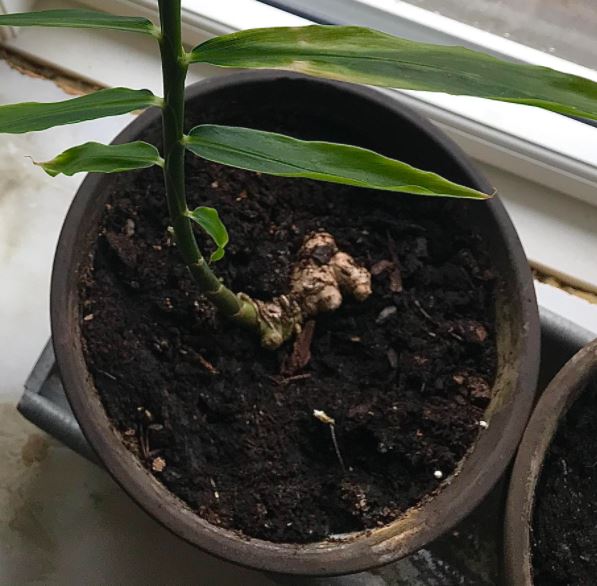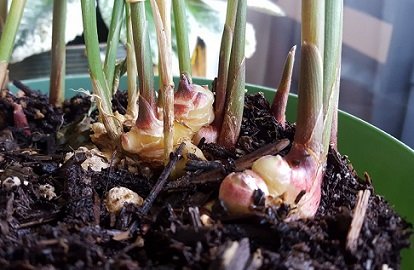Growing ginger comes with its own set of problems leading to a reduction in the quantity or quality of ginger. Thus it becomes a priority to diagnose issues caused due to ginger diseases or maybe ginger pests.
Ginger diseases can impact both the farmers producing ginger on large scales or even gardeners cultivating ginger at home. This would lead to a drastic reduction of your output and resources being wasted.
Having sound knowledge about ginger diseases, spread, and symptoms can be effectively used to reduce or eliminate ginger spoilage. This assures a decent harvest of healthy and flavorful ginger rhizomes.
Some diseases are brought about by soil (soil-borne diseases) while others are induced by insects (vector-borne diseases). Some may even originate from water (water-borne diseases).
Common Ginger Diseases
Here are a few ginger diseases that you are likely to encounter when growing ginger, be it large scale or small scale.
1. Bacterial Soft Rot
Bacterial Soft Rot commonly affects plants that have dedicated fleshy storage organs like ginger. The culprits that cause this disease are gram-negative bacteria such as Erwinia, Pseudomonas, or Pectobacterium.
This disease affects the entire plant starting from the rhizome and slowly progressing to the leaves and stems. They in turn start to become yellow and develop lesions. The plant eventually loses its structural form.
The bacteria work by expelling special digestive enzymes. These digestive enzymes dissolve the cell walls of ginger plants making inner cell fluid nutrients available to bacteria.
Effects on Ginger Plants and Rhizomes
- Rhizomes and plants become mushy
- Plant becomes discolored
- Rhizome gives off a foul smell due to rotting matter
- Yellowing of stems and leaves is seen early on in plants affected
Prevention and Management
- Do not use infected seed/rhizomes
- Sanitize storage vehicles, warehouses, and equipment
- Keep temperatures and humidity low in storage warehouses
- Avoid bruising and rough handling during harvesting
- Pest control limits the transmission of this disease via insects
- Rotate crops between host plants and non-host plants
- Remove plant debris after every harvest to ensure reduced infections
2. Bacterial Wilt a.k.a Ginger Blast (caused by Ralstonia solanacearum)
The disease Bacterial Wilt otherwise known as Ginger Blast is yet another bacterial infection that can affect ginger plants. It can lower ginger rhizome output by affecting all areas of the plants.
It affects the xylem tissue which is the transport system of plants. When it is attacked, it loses the ability to transport vital fluids from the roots to the stems and leaves.
Once this vital tissue is infected, effects start to show as soon as 5 to 7 days after infection.
The main source of this bacteria is from the soil or from the remaining plant matter of previous plantations that were infected. You may not know how badly your ginger harvest is until you cut the rhizomes.
Effects on Ginger Plants and Rhizomes
- Infected leaves wilt (curl towards the underside)
- Leaves lose their green color and necrosis occurs
- Rhizomes rot from the inside and appear discolored and wet
- Roots end up rotting and the plant dies
Prevention and Management
- Crop rotation keeps soil infections under control
- Planting resistant ginger seeds
- Use well-draining soils for ginger plants
- Make use of raised mounds for planting ginger whenever possible
3. Dry Rot (caused by Fusarium and Pratylenchus complex)
Dry Rot in ginger is caused by either a fungus or the presence of nematodes, maybe both in some cases.
Early symptoms are displayed on the leaves. Yellowing leaf tips are the first sign of dry rot disease. The spread is usually slow but still highly damaging to the final harvest.
Advanced symptoms include complete yellowing of the leaves, stunted growth, and eventually, ginger rhizomes are impacted as well. Dry Rot differs from Soft Rot since peels do not slip off so easily in the case of soft rot.
Effects on Ginger Plants and Rhizomes
- Initial yellowing of leaves
- Reduction in ginger plant growth
- Brown rings form in the ginger rhizomes near the cortical region
- Reduced ginger output (spoilage occurs in the form of patches of plants)
Prevention and Management
- Avoid waterlogged fields
- Till the soil and allow the sun to penetrate through
- Use treated ginger rhizomes
- Practice adequate crop rotation
4. Colletotrichum Leaf Spot
As the name suggests, Colletotrichum Leaf Spot is a disease that affects the leaves of ginger plants. The edges of leaves and the tips become scarred by brown spots which work their way inwards.
The spots initially take up an ellipsoid or spindle shape. Slowly the spots start to encroach inwards. Most of the spots have a circular halo that usually has a different color than the rest of the spot.
This ginger disease eventually leads to diminished plants.
This disease stays viable in the soil and on plants throughout winters in the form of resistant mycelia and spores. Small insects and water are the major methods by which this disease is transmitted.
Effects on Ginger Plants and Rhizomes
- Poor yields (reduction in size, quality, and number of ginger rhizomes)
- Dead leaves are unable to carry out photosynthetic processes
- Undernourished plants with minimal growth
Prevention and Management
- Practice crop rotation between various plants
- Burn and dispose of infected matter
- Apply N, P, and K, fertilizers in small doses at regular intervals
5. Ginger Leaf Spot or Phyllosticta Blight (caused by Phyllosticta zingiberi)
You can identify Ginger Leaf Spot disease by the presence of white or yellow spots on the surface of the leaves. These spots bear a spindle shape and are long or round. Their size ranges from 2 to 5 cm.
After some time, the central area of these spots becomes thin and papery and continuously grows. They combine to create larger spots/lesions on the leaves.
As time goes by, these spots greatly decrease the capacity of the leaves to carry out photosynthesis.
Younger leaves are the first to show the impact of the disease. This fungus circulates in fields with the help of rainwater or excess water.
Effects on Ginger Plants and Rhizomes
- Creates spots on leaves leading to the death of leaves
- Reduces the number and size of ginger rhizomes
- Effects are immediate and plants may not develop properly.
Prevention and Management
- Use disease-free ginger for planting
- Do not delay the complete removal of infectious plant debris
- Practice long-term crop rotation (2-3 year rotation)
- Use soils with excellent drainage or plant ginger on higher ground
- Limit fertilizer use and control Nitrogen levels in the soil

Tips to Control Ginger Diseases
Most often, diseases are caused by unsanitary conditions. But even with optimal conditions, the disease may occur. The most common cure for plant diseases is chemicals.
Let us look at the common methods to control diseases besides using fungicides and other chemicals.
1. Crop Rotation
Crop rotation is a practice that many farmers and gardeners around the world have adopted for better disease-free produce.
It involves the alternating growing of susceptible plants followed by unsusceptible plants on the same piece of land or area.
Crop rotation occurs in varying time periods; 1-year gaps, 3-year gaps, or even 5-year gaps depending on the severity of the disease/pest.
Reduce high populations of pathogenic soil bacteria by growing non-host plants after host plants.
2. Good Drainage
Well draining soil is essential not just for best ginger growth but also to help stop the spread of disease through the water.
Diseases present in the soil easily use water as a mode of traveling to other areas in the field.
Flooded areas in combination with high temperatures and humidity can lead to an increase in bacteria and fungi populations.
Good soil helps to keep disease and pests in check before they become unmanageable.
Ginger Pests: How Do These Insects Affect Your Ginger? Tips to control
3. Good Soil Sanitation
Keeping soil clean and free of waste material is vital. Animal waste products or even plant debris can act as the initiator of ginger diseases.
After every cultivation and harvest, remaining plants, leaves, stems, and roots, must be completely removed and disposed of safely.
Good sanitation practices are a must since they also work to reduce and eliminate the number of pests (mice, insects, and birds).
4. Sterilized Equipment
In most cases, infected tools and equipment act as the carrier of the disease.
Through them, a cycle can develop by which the infected plants can also infect others and deposit the pathogens into the soil.
5. Genetically Modified Ginger Variants
Wherever possible, these ginger variants are better since they show resistance to some diseases.
While we love Organic ginger but it may have weaker DNA, making it more susceptible to all sorts of diseases.
Why are my ginger leaves turning yellow?
The yellowing of ginger leaves can be a sign of more than a few diseases, it could even be caused by unfavorable conditions.
If it is severe, it could be due to Soft Rot, Bacterial Wilt, or even Dry Rot. In some cases, you will not be able to pick up on ginger diseases until harvest time.
Poor rhizome quality and size are common indications that your ginger crop has been ravished by disease.

